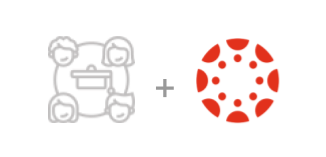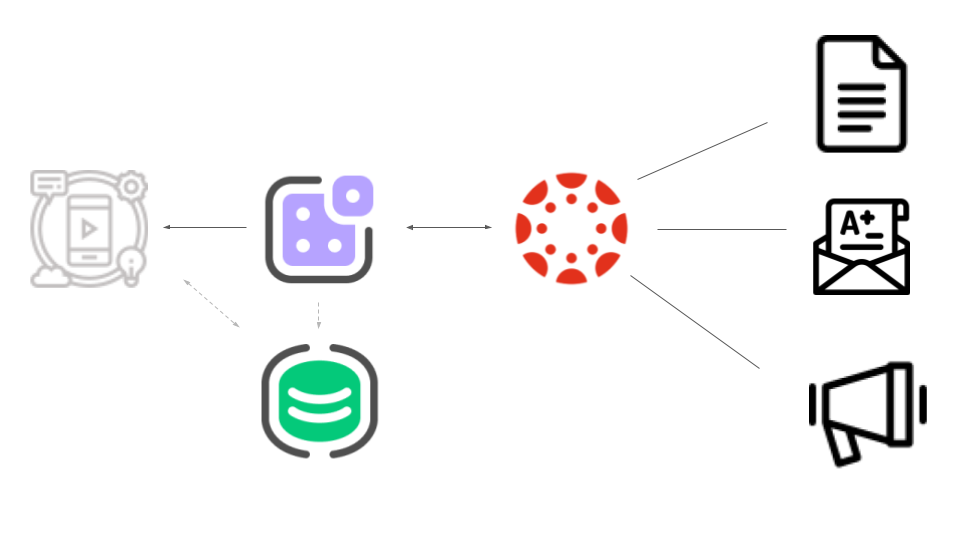
Multiple use cases for Canvas
A range of the most common Canvas use cases in a single recipe
Implement this recipe as a starting point for integrating Canvas with your student digital experience.
- Get new or updated grades from Canvas
- Receive course announcements
- Get information about new or updated assignments from Canvas

It’s easy to delete flows for use-cases you don’t need, and you can customise flows if you have additional requirements.
Note:
The recipe contains three integration flows, each of them providing different interactions with Canvas data to serve different use cases. You can extend each flow by replacing the last HTTP reply step with a REST step in order to send the formatted notification data to a web/mobile application or a message service.
Here is more details about each flow within this recipe:
- Process grade update event
- This flow is triggered by the Canvas webhook event when a grade update event takes place in Canvas. The Connect flow webhook url is assigned after the the recipe is activated, then this url can be set in your Canvas system for the Canvas grade change event.
- Receive course announcements
- This flow polls the Canvas course announcement data on a scheduled basis. You can configure how frequently the flow should run after the recipe is activated.
- Process assignment update event
- This flow is triggered by the Canvas webhook event when an assignment is updated in Canvas. The Connect flow webhook url is assigned after the the recipe is activated, then this url can be set in your Canvas system for the Canvas assignment change event.
- It also integrates with Squiz datastore student experience blueprint for storing the latest status of assignments.
It’s easy to integrate using a Recipe. All you need is the right credentials to connect. We recommend you test the integration with a Sandbox account before using it in production.
- Click the Activate recipe button to deploy this Recipe in Squiz Connect.
- Sign into Squiz Connect if you’re not already signed in.
- Follow the on screen instructions to finish deploying the Recipe.
Connect to Canvas LMS
When activating the recipe, a valid Canvas credential is required to authenticate the Squiz Connect Canvas Component with your Canvas instance.
Create a developer key in your Canvas LMS instance
- Visit the Canvas portal Admin section, signing in if required.
- On the Developer keys page, click on + Developer Key, then choose + API Key.
- Specify an appropriate Name (e.g. 'Connect') and fill the authorized owner email address.
- Copy the following URL value and paste it into the Redirect URLs field:
https://app.connect.squiz.cloud/callback/oauth2 - The Canvas option should be selected by default in the Client Credentials Audiences dropdown list.
- Click Save.
Create your Canvas credential in Connect
- Click Add New Credential.
- Select OAuth2 as the type from the dropdown list.
- Click + Add New Auth Client from Choose Auth Client
- In the Add Auth Client modal, assign a name for this auth client - e.g. 'Canvas LMS' or 'Canvas Oauth client'.
- Go to the Canvas Admin portal Developer keys page, and copy the Detail column Value of the relevant developer key. Paste this value into the Client ID field on the Add Auth Client modal in Connect.
- Return to the Canvas Admin portal Developer keys page and click on Show Key for the relevant developer key. Paste this value into the Client Secret field on the Add Auth Client modal in Connect.
- Enter the following value in the Authorization Endpoint field:
https://<YOUR_CANVAS_URL>/login/oauth2/authreplacing
<YOUR_CANVAS_URL>with your actual Canvas instance URL. https://your-canvas-instance/login/oauth2/auth - For the Token Endpoint field, enter the value:
https://<YOUR_CANVAS_URL>/login/oauth2/tokenagain, replacing
<YOUR_CANVAS_URL>with your actual Canvas instance URL. - Click the Create to save the auth client. Your new auth client is ready to be selected in the Choose Auth Client dropdown list.
- On the New Credential screen Name Your Credential field, update the default name of your Canvas component’s credential to represent the Canvas configuration above - e.g. 'My Canvas LMS credential' or 'Canvas integration credential'.
- The Scopes (Comma-separated list) and Additional parameters (Comma-separated list) fields are optional. The default value is
offline_accessfor the Scopes field andaccess_type:offlinefor the Additional parameters field. - Click Authenticate, a pop-out consent window should show. Sign in if required, then click the Authorize button to authorize the connection
- If Connect has been correctly integrated with Canvas, Connect should indicate Success.
- Click Save on the New Credential screen.
You can now complete the remainder of the Canvas recipe activation steps.
| Type | Recipe |
|---|---|
| For |  Integrations (Connect) Integrations (Connect) |
| Flows | 3 |
| Documentation | |
 Squiz Marketplace
Squiz Marketplace